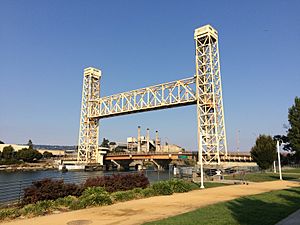Fruitvale Bridge facts for kids
Quick facts for kids Fruitvale Bridge |
|
|---|---|

Fruitvale Avenue railroad bridge (foreground), Miller-Sweeney bridge in background
|
|
| Carries | railroad |
| Crosses | Oakland Estuary |
| Locale | San Francisco Bay Area |
| Characteristics | |
| Design | Vertical-lift bridge |
| Material | steel |
| Height | 175 ft (53 m) |
| Clearance below | 65 ft (20 m) (raised) |
| History | |
| Closed | 2000 |
| Lua error in Module:Location_map at line 420: attempt to index field 'wikibase' (a nil value). | |
| Fruitvale Avenue Bridge | |
|---|---|

Partially raised bascule on road bridge, immediately behind rail bridge.
|
|
| Carries | cars and trucks on Fruitvale (Oakland) and Tilden Avenues (Alameda) |
| Official name | Miller-Sweeney Bridge |
| Characteristics | |
| Design | Single leaf bascule bridge |
| Material | steel, concrete |
| Total length | 215 ft (66 m) |
| Width | 52 ft (16 m) roadway 6 ft 1 in (1.85 m) sidewalks |
| Clearance below | 15 ft (4.6 m) (high tide) 21 ft (6.4 m) (low tide) |
| History | |
| Designer | McCreary-Koretsky International |
| Constructed by | Hensel Phelps |
| Fabrication by | Kaiser Steel |
| Statistics | |
| Daily traffic | 15,300 |
The Fruitvale Bridge and the Fruitvale Avenue Bridge are two important bridges. They cross the Oakland Estuary in California. These bridges connect the cities of Oakland and Alameda. The Fruitvale Bridge is a special railroad bridge that lifts up. The Fruitvale Avenue Bridge, also called the Miller-Sweeney Bridge, is a road bridge that opens like a seesaw.
Contents
Fruitvale Bridges: Connecting Oakland and Alameda
The Rail Bridge
The rail bridge is right next to the Miller-Sweeney road bridge. It used to connect Fruitvale Avenue in Oakland with Tilden Way in Alameda. This bridge has not been used since the year 2000.
History of the Rail Bridge
This lift bridge was built in 1951. It replaced an older bridge that trains used to cross. From 1951 until 1996, the Southern Pacific Railroad used it for freight trains. These trains served businesses in Alameda.
In 1996, Union Pacific took over Southern Pacific. Union Pacific used the bridge only a few times. By 2000, train service stopped completely.
How the Rail Bridge Works
Even though no trains cross it, the bridge still stands. The tracks on both sides are now disconnected. The bridge's middle section stays lifted 65 feet above the water. It only moves down for maintenance and testing.
The U.S. Army Corps of Engineers owns this bridge. The County of Alameda operates it. A county employee controls the rail bridge from the nearby Miller-Sweeney bridge's control room.
The Road Bridge
The road bridge is officially called the Miller-Sweeney Bridge at Fruitvale Avenue. Unlike other bridges in the area, it has no tall steel frame above the road. This means very tall vehicles can use it easily. The Miller-Sweeney Bridge opens about 1,600 times each year. It opens to let boats and ships pass through the estuary.
History of the Road Bridge
An older railroad bridge first opened here in 1894. It was a swing bridge, which means it rotated to open. In 1951, the train tracks were removed. This happened when the new rail lift bridge was finished.
The current Miller-Sweeney Bridge was completed in 1973. The U.S. Army Corps of Engineers built it. In 1975, it was given to Alameda County. This bridge even won an award in 1974 for its design.
The Miller-Sweeney Bridge was damaged in the 1989 Loma Prieta earthquake. It was hit again in 1991 by a large barge.
How the Road Bridge Works
The Miller-Sweeney Bridge usually opens using two powerful 75-horsepower motors. It takes about 66 seconds for the bridge to open fully. These motors get their power from Alameda Municipal Power. If there's an emergency, a smaller backup motor can open the bridge. This backup motor takes about 20 minutes to open the bridge completely.

